Many common beautiful flowers can be dangerous for doodles. If your doodle accidentally nibbles and swallows these colorful flowers, an emergency trip to the closest veterinarian is in order.
If your doodle ingest a poisonous flower, what should you do?
The best bet is to be safe than sorry. If your doodle is vomiting or excessive drooling, or refuses to eat, go to the vet immediately.
If your doodle displays signs of skin irritation, such as blisters or rashes, your doodle might have accidentally brushed up against a toxic flower and developed a skin reaction.
If you have any questions about whether or not a flower could cause signs of poisoning in your pet, get in touch with your vet or the ASPCA Animal Poison Control Center.
You can reach the AAPC by calling (888) 426-4435.11
Safety First
Always keep a pet first aid kit on hand, whether you assemble it yourself (Pet Poison Helpline has a handy list) or buy a pre-made one.
On your fridge or somewhere convenient, keep a list of emergency phone numbers: your veterinarian’s phone number, the number of a local 24 hour emergency vet, the ASPCA Animal Poison Control Center (888) 426-4435, and the Pet Poison Helpline (855) 764-7661.
This blog is to help increase your awareness of the popular flowers toxic to doodles.
Doodles are curious, especially when young puppies. If your doodle likes to nibble on something, then this list of poisonous flowers for doodles will help. When it comes to toxic items, doodles are generally smart enough not to go chewing on a poisonous thing. Avoid keeping the following flowers in your house, backyard and front yard.
Here are some of the dangerous flowers you should never have in your home if you have an indoor pet. The toxins these flowers produce can lead to a wide range of problems, ranging from skin irritation to death.
If you already own one of these doodle-toxic flowers, it’s best to give it away. If you just can’t part with your flower, place it somewhere where your doodle will never be able to reach it, such as a very high shelf or window sill.
After reading, check out these doodle-safe flowers that work well in most any garden.
Amaryllis
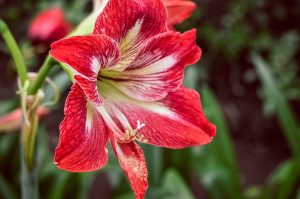
She is gorgeous. The Naked Lady amaryllis will cause vomiting, diarrhea, abdominal pain, tremors and a nonexistent appetite if eaten. Amaryllis belongs to the lily family, but it is mildly poisonous when compared to other lilies like Easter lily, daylily, Asiatic lily, tiger lily, lily of the valley and flame lily.
Autumn Crocus

The autumn crocus belongs to the Lily family. For doodles, ingestion can be dangerous – bloody vomiting, diarrhea, multi-organ damage, and seizures are not unusual. The bulbs of the are the most toxic part of the autumn crocus.
Azalea
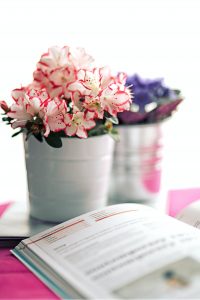
Your doodle ate an azalea flower? It only takes a few leaves to lead to side effects as serious as blindness, seizures, comas, or even death.
If you catch your doodle eating azalea, or presenting food poisoning–like symptoms (vomiting, diarrhea, abdominal pain, etc.) seek veterinary care immediately. Beloved for its beautifully colored flowers, the azalea is a popular garden flower. The ingestion of just a few azalea leaves can cause dangerous reactions, including vomiting, diarrhea and, in the severest cases, even death. Keep your Doodle away from this flowering shrub.
Baby's Breath
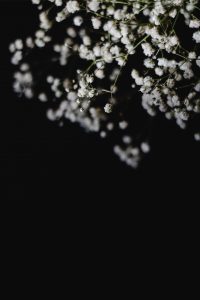
Baby’s Breath is a lovely but unfortunately, a quick way to make your doodle’s intestinal tract hate him.
Begonia
Your doodle ate a begonia? It’s not a serious problem unless he ate a lot of it. It’s toxic, but the symptoms are often only as severe as some drooling, difficulty swallowing, and vomiting.
Bird of Paradise
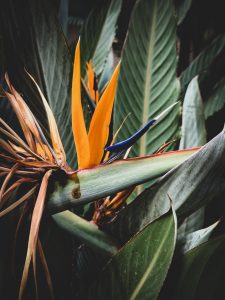
The bird of paradise is flamboyant and dangerous if your Doodle eats it. You can expect nausea, vomiting, and drowsiness, difficulty in breathing, less appetite and death within 20 minutes or so, if your doodle tastes the bird of paradise. This poisonous flower for doodles contain Hydrogen Cyanide (prussic acid).Hydrogen cyanide was used by Iraq in the war against Iran. During the Second World War, a form of hydrogen cyanide (Zyklon B) was used in the Nazi gas chambers.
Brunfelsia
Brunfelsia whose other popular names are Yesterday, Today, Tomorrow, Kiss-Me-Quick, Lady-of-the-Night contains a stimulant toxin called brunfelsamidine and other toxic agent called hopeanine, which is a depressant.
If your doodle munches on brunfelsia then they may display irritation of the mouth and stomach (salivation, vomiting, and diarrhea), muscle cramps, muscle rigidity, paralysis of the nervous system and possibly coma.
Desert Rose
Adenium obesum is a beautiful succulent with thick leaves and stems and produces a flower usually in a white with pink or all pink color pattern. This plant does well inside and outside, especially if you live in a warmer climate. While this plant is a gorgeous addition to your home, you may want to think twice before bringing it home.
If your doodle licks or ingests any part of this plant, he can be poisoned. The desert rose contains digitalis which is a cardiac glycoside toxin.
This toxin interferes with the electrolyte balance of the heart muscle. Cardiac glycosides inhibit the sodium-potassium pump which allows the heart to work more efficiently. Cardiac glycosides are medications commonly prescribed to dogs with heart problems.
However, when given to or ingested by a healthy dog, it leads to toxicity and possibly even death.
He may only develop mild symptoms such as gastrointestinal upset, or he may develop more serious symptoms such as cardiac issues that can lead to death. The sooner you seek veterinary help for your dog, the better his prognosis of recovering.
Calla Lily

Calla lilies are one of the poisonous flowers for doodles. When the flower is chewed, clinical signs are visible immediately. All parts of the flower contain insoluble calcium oxalate and toxic alkaloids. If eaten, your doodle may show oral pain, diarrhea, drooling, lack of appetite, pawing at the mouth.
Carnation
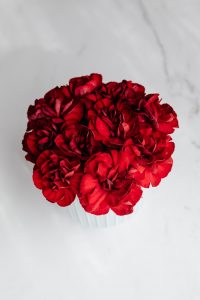
Let’s say you received a bundle of carnations for your birthday. Your doodle promptly ate them for dinner. Your carnations will probably be gifted back as vomit or diarrhea.
Cyclamen
The cyclamen’s white, pink, red, and purple petals make for a stunning showing, but ingesting a large number of cyclamen tubers will result in salivation, vomiting, diarrhea and at high intake cardiac, arrhythmia and convulsions might occur and possibly death for doodles. Cyclamen contains saponins. If its roots are ingested, it requires veterinary attention.
Daffodil
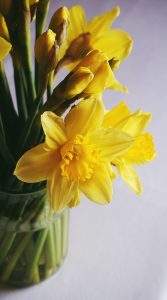
Daffodils are stunningly gorgeous flowers, known for their bright yellow, star-shaped blooms. They’re everywhere, bright and yellow and perfect—and poisonous. Eating one will lead to symptoms like vomiting, diarrhea, low blood pressure, tremors, and heart problems for doodles. No part of the daffodil is safe for a doodle to eat, and the bulb is especially toxic. If you think your doodle has eaten a daffodil and they show any signs of poisoning (including vomiting, diarrhea, or convulsions) get them to the vet immediately.
Desert Rose
Desert rose contains a toxin called cardiac glycoside. This poison can cause symptoms including vomiting, diarrhea, depression, irregular heart rhythm, and even death.
Flame Lily (Gloriosa Superba)
A beautiful ornamental flower, its flowers look like a flame. It can also be grown as a houseflower and particularly used as a medicinal flower and have a variety of uses in Ayurveda. Apart from all these facts, it is useful to know that like most lilies, flame lily comes in the list of toxic flowers to doodles. All parts are poisonous but mostly the tubers (swollen, underground stems). The ingestion of flame lily has caused many accidental deaths. It has also been used to commit murder, suicide, and to poison doodles. Symptoms include salivation, vomiting (bloody), diarrhea (bloody), shock, kidney failure, liver damage, bone marrow suppression, paralysis and death.
Flamingo Flower (Anthurium Scherzeranum)
Flamingo flowers contain calcium oxalates that can irritate the mouth and other mild clinical symptoms if ingested.
All parts of the flower can cause mucous membrane irritation, intense burning, and irritation of the mouth, lips, and tongue, excessive drooling, and difficulty in swallowing.
Gardenia
Gardenia is one of the most fragrant flowers in the world. However, if you are growing gardenia as a houseflower, you must know that it is mildly poisonous. All parts of the can cause nausea and vomiting like symptoms to your pet, after ingestion.
Geranium
Usually, pets don’t touch this flower, but geranium can cause mild clinical symptoms to your doodle.All parts of the flower can cause vomiting, anorexia, dermatitis.
Kafir Lily
Kafir lily can be grown as a houseflower. It is also one of the toxic flowers to doodles.
The whole flower is poisonous with licorice and other alkaloids, but especially the base of the leaf, stem, and bulbs. If your doodle consumes kafir lily, she may start vomiting, releasing diarrhea, convulsing, and showing low blood pressure, tremors, and cardiac arrhythmia.
Kalanchoe

Kalanchoe contains a naturally occurring poison that affects the heart.
The toxins are ufadienolides , which are found in all parts of the flower. Your doodles’ symptoms will be vomiting, diarrhea, and abnormal heart rhythm (rare)
Lilies

No matter the variety (and there are lots of ’em), lilies aren’t good for your doodle. They aren’t deadly but can cause gastrointestinal issues, depression, anorexia, and tremors in doodles.
Monkshood
With colorful violet petals, the monkshood is known as the “wolfsbane,” which are some clues that pretty petals weren’t good for doodles. The toxins in monkshood can affect the nervous system and result in symptoms like weakness, paralysis, seizures, and arrhythmias.
Mistletoe & Poinsettia
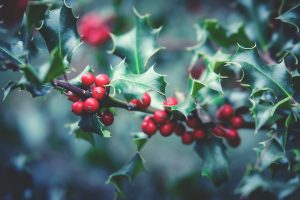
These flowers are staples of just about any home’s Christmas decorations. You will need to keep them out of your home (or out of your doodle’s reach) this holiday season. Poinsettia sap can irritate a doodle’s esophagus and mouth, and can also lead to nausea.
Thankfully, serious poisoning from poinsettias isn’t common. Most doodles won’t eat enough to get really sick because the flower tastes bad.
Ingestion of mistletoe can lead to very dangerous issues, including a rapid drop in blood pressure and breathing difficulty. Doodles who ingest mistletoe berries risk suffering seizures and even dying. Please, keep this flower out of your home.
Think about bringing home an artificial mistletoe(made from plastic or fabric) or a Christmas cactus for the holidays instead. A Christmas cactus is non-toxic for doodles.
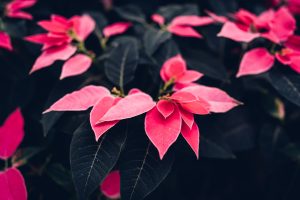
Oleander
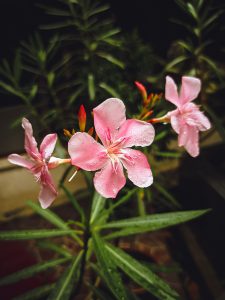
The pale pink petals sure look pretty, but in the world of toxic flowers for doodles, oleander is near the top.
Virtually all parts of the flower are considered toxic—even the water in a vase. Signs of poisoning range from gastrointestinal issues to more serious symptoms including tremors, seizures and, unfortunately, death.
Tulips
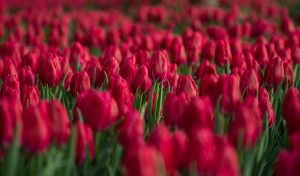
Let’s pretend your doodle dug up those tulip bulbs you just flowered in the garden and cleverly decided to swallow them. One might lead to some irritation in the mouth, including drooling and difficulty swallowing.
Several swallowed tulip bulbs could cause vomiting, diarrhea, an increased heart rate, and even issues breathing. As with the daffodil, the tulip is a stunning, but poisonous, flower with a very toxic bulb.
Consider indoor flowers — the kind that you may receive as a gift and place in a vase. Both tulips and daffodils are popular gifts. That’s not to say that you can’t have them, but they must be well out of reach of your doodle. Be especially careful once they start to wilt, because the flowers can fall to the floor, where your doodle may ingest them causing a coma. It can even be fatal.
Though it’s almost impossible to know every flower poisonous to your doodles, making yourself aware of some of the most common and dangerous toxic flowers is a great start. Don’t be deceived by gorgeous blooms and houseflowers. They can be some of the worst toxins!
